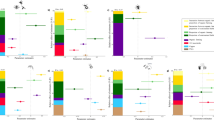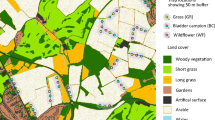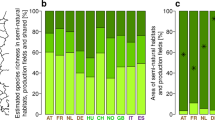Abstract
Intensive cereal monoculture is currently the main cause of biodiversity decline in Europe. However, it is difficult to disentangle the effects of intensive monoculture (e.g. pesticide use, mechanical ploughing and reduced protective cover), let alone evaluate how far the reduction of crop diversity affects biodiversity. It remains unclear to which extent the consequent decrease in food resources affects farmland biodiversity, and particularly vertebrate species. We therefore designed this study in mesocosms to investigate the effects of monoculture crops (organic wheat or corn seeds) and mixed crops (a combination of organic wheat, corn, sunflower and alfalfa seeds) on (1) the species richness of weeds and invertebrates and (2) the reproductive success of the European hamster (Cricetus cricetus), a critically endangered umbrella species of European farmlands. We found a negative impact of organic monoculture crops on plant and invertebrate species richness, with values respectively 38% and 28% lower than those obtained for mixed organic crops. The reproductive success of hamsters was reduced by 82% in monoculture mesocosms. These results highlight that monoculture per se can be detrimental for farmland biodiversity (i.e. from plants to vertebrates), even before taking into account the use of pesticide and mechanization. We believe that future research should further consider how food reduction in agroecosystems affects farmland wildlife, including vertebrates. Moreover, we argue that conservation actions must focus on restoring plant diversity on farmland to reverse the observed trend in farmland wildlife decline.




Similar content being viewed by others
References
Altieri MA (1999) The ecological role of biodiversity in agroecosystems. Agric Ecosyst Environ 74:19–31
Asteraki EJ, Hart BJ, Ings TC, Manley WJ (2004) Factors influencing the plant and invertebrate diversity of arable field margins. Agric Ecosyst Environ 102:219–231. https://doi.org/10.1016/j.agee.2003.07.003
Baker AN, Dunning RA (1975) Some effects of soil type and crop density on the activity and abundance of the epigeic fauna, particularly Carabidae, in sugar-beet fields. J Appl Ecol 12:809–818
Benton TG, Vickery JA, Wilson JD (2003) Farmland biodiversity: is habitat heterogeneity the key? Trends Ecol Evol 18:182–188. https://doi.org/10.1016/S0169-5347(03)00011-9
Björklund J, Limburg KE, Rydberg T (1999) Impact of production intensity on the ability of the agricultural landscape to generate ecosystem services: an example from Sweden. Ecol Econ 29:269–291
Changguo X, Pingjiu Z, Genxing P et al (2006) Changes in diversity, protein content, and amino acid composition of earthworms from a paddy soil under different long-term fertilizations in the Tai Lake Region, China. Acta Ecol Sin 26:1667–1674
Dance C, Botias C, Goulson D (2017) The combined effects of a monotonous diet and exposure to thiamethoxam on the performance of bumblebee micro-colonies. Ecotoxicol Environ Saf 139:194–201
Decourtye A, Mader E, Desneux N (2010) Landscape enhancement of floral resources for honey bees in agro-ecosystems. Apidologie 41:264–277. https://doi.org/10.1051/apido/2010024
Ernandes M, La Guardia M, Giammanco S (1996) Maize based diets and possible neuro-behavioural after-effects among some populations in the world. Hum Evol 11:67–77
Evans A (1997) The importance of mixed farming for seed-eating birds in the UK. In: Pain DJ, Pienkowski MW (eds) Farming and birds in Europe: the common agricultural policy and its implications for bird conservation, chap 12, pp 331–357
Fargione JE, Cooper TR, Flaspohler DJ et al (2009) Bioenergy and wildlife: threats and opportunities for grassland conservation. Bioscience 59:767–777. https://doi.org/10.1525/bio.2009.59.9.8
Finn JA, Kirwan L, Connolly J et al (2013) Ecosystem function enhanced by combining four functional types of plant species in intensively managed grassland mixtures: a 3-year continental-scale field experiment. J Appl Ecol 50:365–375. https://doi.org/10.1111/1365-2664.12041
Fischer C, Wagner C (2016) Can agri-environmental schemes enhance non-target species? Effects of sown wildflower fields on the common hamster (Cricetus cricetus) at local and landscape scales. Biol Conserv 194:168–175. https://doi.org/10.1016/j.biocon.2015.12.021
Foley JA, Defries R, Asner GP et al (2005) Global consequences of land use. Science 309:570–574. https://doi.org/10.1126/science.1111772
Gorecki A, Grygielska M (1975) Consumption and utilization of natural foods by the common hamster. Acta Theriol (Warsz) 20:237–246
Goulson D, Nicholls E, Botías C, Rotheray EL (2015) Bee declines driven by combined stress from parasites, pesticides, and lack of flowers. Science (80-) 347:1–16. https://doi.org/10.1126/science.1255957
Humphries MM, Thomas DW, Kramer DL (2003) The role of energy availability in mammalian hibernation: a cost-benefit approach. Physiol Biochem Zool 76:165–179
Kayser A, Weinhold U, Stubbe M (2003) Mortality factors of the common hamster Cricetus cricetus at two sites in Germany. Acta Theriol (Warsz) 48:47–57
Kourkgy C, Eidenschenck J (2015) Délivrable Action D1. Rapport annuel de présentation des données collectées et premières analyses, année 2014. Strasbourg
La Haye M, Müskens G, Van Kats R et al (2010) Agri-environmental schemes for the common hamster (Cricetus cricetus). Why is the Dutch project successful? Asp Appl Biol 100:117–124
La Haye MJJ, Swinnen KRR, Kuiters AT et al (2014) Modelling population dynamics of the common hamster (Cricetus cricetus): timing of harvest as a critical aspect in the conservation of a highly endangered rodent. Biol Conserv 180:53–61. https://doi.org/10.1016/j.biocon.2014.09.035
Labruyere S, Ricci B, Lubac A, Petit S (2016) Crop type, crop management and grass margins affect the abundance and the nutritional state of seed-eating carabid species in arable landscapes. Agric Ecosyst Environ 231:183–192. https://doi.org/10.1016/j.agee.2016.06.037
Medan D, Torretta JP, Hodara K et al (2011) Effects of agriculture expansion and intensification on the vertebrate and invertebrate diversity in the Pampas of Argentina. Biodivers Conserv 20:3077–3100. https://doi.org/10.1007/s10531-011-0118-9
Monecke S (2013) All things considered? Alternative reasons for hamster extinction. Zool Pol 58:41–57. https://doi.org/10.2478/zoop-2013-0004
Munro D, Thomas DW, Humphries MM (2008) Extreme suppression of aboveground activity by a food-storing hibernator, the eastern chipmunk (Tamias striatus). Can J Zool 86:364–370. https://doi.org/10.1139/Z08-008
Nechay G, Hamar M, Grulich I (1977) The common hamster (Cricetus cricetus [L.]); a review. EPPO Bull 7:255–276
Nyfeler D, Huguenin-Elie O, Suter M et al (2009) Strong mixture effects among four species in fertilized agricultural grassland led to persistent and consistent transgressive overyielding. J Appl Ecol 46:683–691. https://doi.org/10.1111/j.1365-2664.2007.0
O’Brien J (2015) Saving the common hamster (Cricetus cricetus) from extinction in Alsace (France): potential flagship conservation or an exercise in futility? Hystrix Ital J Mamm. https://doi.org/10.4404/hystrix-26.2-11230
Out ME, Van Kats RJM, Kuiters L, et al (2011) Hard to stay under cover: seven years of crop management aiming to preserve the common Hamster (Cricetus cricetus) in the Netherlands. In: Angermann R, Görner M, Stubbe M (eds) Proceedings of the 16th and 17th meeting of the international hamster workgroup, 2009, Ranis, Germany, 2010, Gödollo, Hungary. Säugetierkundliche Informationen, pp 37–50
Pietsch D, Kühn P, Lisitsyn S et al (2014) Krotovinas, pedogenic processes and stratigraphic ambiguities of the Upper Palaeolithic sites Kostenki and Borshchevo (Russia). Quat Int 324:172–179. https://doi.org/10.1016/j.quaint.2013.05.036
Rands MRW, Sotherton NW (1986) Pesticide use on cereal crops and changes in the abundance of butterflies on arable farmland in England. Biol Conserv 36:71–82. https://doi.org/10.1016/0006-3207(86)90102-3
Reznik-Schuller H, Reznik G, Mohr U (1974) The European hamster (Cricetus cricetus L.) as an experimental animal: breeding methods and observations of their behaviour in the laboratory. Zeitschrift Versuchtierkd 16:48–58
Rioux Paquette S, Pelletier F, Garant D, Belisle M (2014) Severe recent decrease of adult body mass in a declining insectivorous bird population. Proc R Soc B Biol Sci 281:20140649. https://doi.org/10.1098/rspb.2014.0649
Schneider JE (2004) Energy balance and reproduction. Physiol Behav 81:289–317. https://doi.org/10.1016/j.physbeh.2004.02.007
Speakman JR (2008) The physiological costs of reproduction in small mammals. Philos Trans R Soc Lond B Biol Sci 363:375–398. https://doi.org/10.1098/rstb.2007.2145
Surov A, Banaszek A, Bogomolov P et al (2016) Dramatic global decrease in the range and reproduction rate of the European hamster Cricetus cricetus. Endanger Species Res 31:119–145. https://doi.org/10.3354/esr00749
Tissier ML (2017) Conservation Biology of the European hamster (Cricetus cricetus): nutritional effects of crops on hamsters fitness and evaluation of their antipredatory behavior to upgrade wildlife underpasses. CNRS-Université de Strasbourg, pp 140–147. PhD thesis available at https://hal.archives-ouvertes.fr/tel-01545873/
Tissier ML, Handrich Y, Robin J-P et al (2016) How maize monoculture and increasing winter rainfall have brought the hibernating European hamster to the verge of extinction. Sci Rep 6:25531. https://doi.org/10.1038/srep25531
Tissier ML, Handrich Y, Dallongeville O et al (2017) Diets derived from maize monoculture cause maternal infanticides in the endangered European hamster due to a vitamin B3 deficiency. Proc R Soc B 284:1–8. https://doi.org/10.1098/rspb.2016.2168
Tsiafouli MA, Thébault E, Sgardelis SP et al (2015) Intensive agriculture reduces soil biodiversity across Europe. Glob Change Biol 21:973–985. https://doi.org/10.1111/gcb.12752
Ulbrich K, Kayser A (2004) A risk analysis for the common hamster (Cricetus cricetus). Biol Conserv 117:263–270. https://doi.org/10.1016/j.biocon.2003.12.006
Van der Putten WH, Mortimer SR, Hedlund K et al (2000) Plant species diversity as a driver of early succession in abandoned fields: a multi-site approach. Oecologia 124:91–99. https://doi.org/10.1007/s004420050028
Vander Wall SB (1990) Food hoarding in animals. University of Chicago Press, Chicago
Vanderplanck M, Moerman R, Rasmont P et al (2014) How does pollen chemistry impact development and feeding behaviour of polylectic bees? PLoS ONE 9:1–9. https://doi.org/10.1371/journal.pone.0086209
Vickery JA, Tallowin JR, Feber RE et al (2001) The management of lowland neutral grasslands in Britain: effects of agricultural practices on birds and their food resources. J Appl Ecol 38:647–664
Villemey A, Besnard A, Grandadam J, Eidenschenck J (2013) Testing restocking methods for an endangered species: effects of predator exclusion and vegetation cover on common hamster (Cricetus cricetus) survival and reproduction. Biol Conserv 158:147–154. https://doi.org/10.1016/j.biocon.2012.08.007
Wade GN, Schneider JE (1992) Metabolic fuels and reproduction in female mammals. Neurosci Biobehav Rev 16:235–272. https://doi.org/10.1016/S0149-7634(05)80183-6
Ward DF, New TR, Yen AL (2001) Effects of pitfall trap spacing on the abundance, richness and composition of invertebrate catches. J Insect Conserv 5:47–53. https://doi.org/10.1023/A:1011317423622
Webb ANR, Clarke RT, Nicholas JT et al (1984) Invertebrate diversity on fragmented Calluna-heathland: effects of surrounding vegetation. J Biogeogr 11:41–46
Weinhold U (2008) Draft European action plan for the conservation of the common hamster (Cricetus cricetus L., 1758). In: Convention on the conservation of European wildlife and natural habitats. In: Standing Commitee. Council of Europe, Strasbourg, France, pp 1–36
Whittingham MJ, Evans KL (2004) The effects of habitat structure on predation risk of birds in agricultural landscapes. Ibis (Lond 1859) 146:210–220. https://doi.org/10.1111/j.1474-919X.2004.00370.x
Wilson JD, Morris AJ, Arroyo BE et al (1999) A review of the abundance and diversity of invertebrate and plant foods of granivorous birds in northern Europe in relation to agricultural change. Agric Ecosyst Environ 75:13–30. https://doi.org/10.1016/S0167-8809(99)00064-X
Wilson JD, Whittingham MJ, Bradbury RB (2005) The management of crop structure : a general approach to reversing the impacts of agricultural intensification on birds ? Ibis (Lond 1859) 147:453–463
Wood TJ, Holland JM, Goulson D (2016) Providing foraging resources for solitary bees on farmland: current schemes for pollinators benefit a limited suite of species. J Appl Ecol. https://doi.org/10.1111/1365-2664.12718
Acknowledgements
We are grateful to Pierre Ulrich for his help and work at the Fort Joffre and to Cédric DeVigne for his advice on invertebrate trapping. Many thanks to Michel Hoff for helping with plant species identification. The experimental protocol followed EU Directive 2010/63/EU guidelines for animal experiments and the care and use of laboratory animals, and was approved by the Ethical Committee (CREMEAS) under agreement number 00624-01. This work was supported by the LIFE + Biodiversity Grant N° LIFE12 BIO/FR/000979 and the Ministère de l’Ecologie, du Developpement Durable et de l’Energie. The funders did not participate in the study design, data collection and analysis, the decision to publish, or the preparation of the manuscript. Many thanks to the anonymous reviewers and the editor who helped improving this manuscript and to Joanna Lignot for copyediting.
Author information
Authors and Affiliations
Contributions
MLT and CH designed the study. MLT and FK collected the data and FK performed invertebrate and plant species identification. MLT carried out statistical analyses and wrote the manuscript. YH, FK and CH contributed significantly to manuscript revisions and gave final approval for publication.
Corresponding author
Additional information
Communicated by Janne Sundell.
Electronic supplementary material
Below is the link to the electronic supplementary material.
Rights and permissions
About this article
Cite this article
Tissier, M.L., Kletty, F., Handrich, Y. et al. Monocultural sowing in mesocosms decreases the species richness of weeds and invertebrates and critically reduces the fitness of the endangered European hamster. Oecologia 186, 589–599 (2018). https://doi.org/10.1007/s00442-017-4025-y
Received:
Accepted:
Published:
Issue Date:
DOI: https://doi.org/10.1007/s00442-017-4025-y




